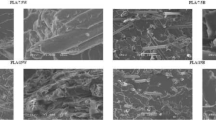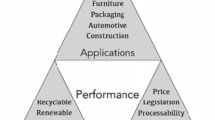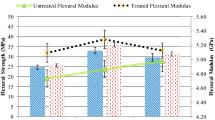Abstract
Polylactic acid (PLA) composites comprising up to 25 wt% cotton linter (CL) or up to 50 % maple wood fibre (WF) were prepared by compounding and injection moulding. A reduction of crystallinity in the PLA matrix was observed as a result of the thermal processing method. These PLACL and PLAWF composites provided excellent improvements in both stiffness (with increases in tensile and flexural modulus) and toughness (increases in notched impact strength) properties over the neat PLA resin, while the tensile and flexural strengths of the composites were generally unchanged, while the strain at break values were reduced in comparison to the neat PLA. DMA results indicated incorporating these fibres caused the mechanical loss factor (tan δ) to decrease, suggesting better damping capabilities were achieved with the composites. SEM analysis of the impact fractured surfaces of the PLACL composites showed debonding-cavitation at the matrix-fibre interface while the PLAWF composites showed good wetting along its matrix-fibre interface. The composting of these composites up to 90 days showed that the degradation onset time was increased when increasing the fibre loadings, but the maximum degree of degradation and the maximum daily rates of degradation were decreased compared to neat PLA. On a weight basis of fibre loading, the PLACL composites had a quicker onset of biodegradation, a higher maximum daily rate of biodegradation and, overall, a higher degree of biodegradation at 90 days than the PLAWF composites, possibly due to the quicker thermal hydrolysis observed in the PLA matrix of the PLACL composites during processing and composting.












Similar content being viewed by others
References
Eichhorn SJ, Baillie CA, Zafeiropoulos N, Mwaikambo LY, Ansell MP, Dufresne A, Entwistle KM, Herrera-Franco PJ, Escamilla GC, Groom L, Hughes M, Hill C, Rials TG, Wild PM (2001) J Mater Sci 36:2107–2131
AWF (2011) American Wood Fibers website. Maryland, USA. www.awf.com. Accessed 22 March 2012
Huda MS, Drzal LT, Mohanty AK, Misra M (2006) Compos Sci Technol 66:1813–1824
Huda MS, Mohanty AK, Drzal LT, Schut E, Misra M (2005) J Mater Sci 40:4221–4229
Huda MS, Drzal LT, Mohanty AK, Misra M (2007) Compos B 38:367–379
Oksman K, Skrifvars M, Selin JF (2003) Compos Sci Technol 63:1317–1324
Braun B, Dorgan JR, Knauss DM (2006) J Polym Environ 14:49–58
Shibata M, Ozawa K, Teramoto N, Yosomiya R, Takeishi H (2003) Macromol Mater Eng 288:35–43
Lee SH, Wang S (2006) Compos A 37:80–91
Plackett D, Løgstrup Andersen T, Batsberg Pedersen W, Nielsen L (2003) Compos Sci Technol 63:1287–1296
Nishino T, Hirao K, Kotera M, Nakamae K, Inagaki H (2003) Compos Sci Technol 63:1281–1286
Chow P, Nakayama FS, Blahnik B, Youngquist JA, Coffelt TA (2008) Ind Crops Prod 28:303–308
Raya SS, Yamada K, Okamoto M, Ueda K (2003) Polymer 44:857–866
Garlotta D (2001) J Polym Environ 9:63–84
Van de Velde K, Kiekens P (2002) Polym Test 21:433–442
Perego G, Cella GD, Bastioli C (1996) J Appl Polym Sci 59:37–43
Liu X, Khor S, Petinakis E, Yu L, Simon G, Dean K, Bateman S (2010) Thermochim Acta 509:147–151
Petinakis E, Liu X, Yu L, Way C, Sangwan P, Dean K, Bateman S, Edward G (2010) Polym Degrad Stab 95:1704–1707
Manikandan Nair KC, Thomas S, Groeninckx G (2001) Compos Sci Technol 61:2519–2529
Pluta M (2004) Polymer 45:8239–8251
Martin O, Averous L (2001) Polymer 42:6209–6219
Kulinski Z, Piorkowska E (2005) Polymer 46:10290–10300
Hiljanen-Vainio M, Heino M, Seppala JV (1998) Polymer 39:865–872
Osswald TA (May 26–27, 1999) In: Proceedings of the 5th international conference of wood fiber–plastic composites Madison, Wisconsin
Ljungberg N, Cavaillé JY, Heux L (2006) Polymer 47:6285–6292
Folkes MJ (1985) In: Bevis MJ (ed) Short fibre reinforced thermoplastics. Research Studies Press, Chichester, p 151
Devi LU, Bhagawan SS, Thomas S (1997) J Appl Polym Sci 64:1739–1748
Wells JK, Beaumont PWR (1985) J Mater Sci 20:1275–1284
Pavithran C, Mukherjee PS, Brahmakumar M (1991) J Reinf Plast Comp 10:91–101
Park SD, Todo M, Arakawa K, Koganemaru M (2006) Polymer 47:1357–1363
Mascia L (1974) In: The role of additives in plastics, chap 3. Edward Arnold, London UK
Zhang F, Endo T, Qiu W, Yang L, Hirotsu T (2002) J Appl Polym Sci 84:1971–1980
Pearson RA, Yee AF (1989) J Mater Sci 24:2571–2580
Rong MZ, Zheng MQ, Zheng YX, Zeng HM, Friedrich K (2001) Polymer 42:3301–3304
Bledzki AK, Gassan J (1999) Prog Polym Sci 24:221–274
Rana AK, Mitra BC, Banerjee AN (1999) J Appl Polym Sci 71:531–539
Petersen K, Nielsen PV, Olsen MB (2001) Starch–Stärke 53:356–361
George J, Thomas S, Bhagawan SS (1999) J Thermoplast Compos Mater 12:443–464
Simonsen J, Jacobsen R, Rowell R (1998) J Appl Polym Sci 68:1567–1573
Liu X, Dever M, Fair N, Benson RS (1997) J Polym Environ 5:225–235
Thomson JL (1990) Polym Compos 11:105–113
Fay JJ, Murphy CJ, Thomas DA, Sperling LH (1991) Polym Eng Sci 31:1731–1741
Mohanty AK, Misra M, Hinrichsen G (2000) Macromol Mater Eng 276–277:1–24
MatWeb (2012) Material Property Data. Online Database. Maple wood properties—various species. www.matweb.com. Accessed 22 March 2012
Bergman R, Cai Z, Carll CG, Clausen CA, Dietenberger MA, Falk RH, Frihart CR, Glass SV, Hunt CG, Ibach RE, Kretschmann DE, Rammer DR, Ross RJ (2010) Wood Handbook, Wood as an Engineering Material. General Technical Report FPL-GTR-190. Forest Products Laboratory, Madison, Wisconsin USA
Acknowledgments
The authors gratefully acknowledge Buckeye Technologies Inc. (USA) for supplying the cotton linter fibres free of charge, and for providing relevant technical information.
Author information
Authors and Affiliations
Corresponding author
Rights and permissions
About this article
Cite this article
Way, C., Wu, D.Y., Cram, D. et al. Processing Stability and Biodegradation of Polylactic Acid (PLA) Composites Reinforced with Cotton Linters or Maple Hardwood Fibres. J Polym Environ 21, 54–70 (2013). https://doi.org/10.1007/s10924-012-0462-1
Published:
Issue Date:
DOI: https://doi.org/10.1007/s10924-012-0462-1




